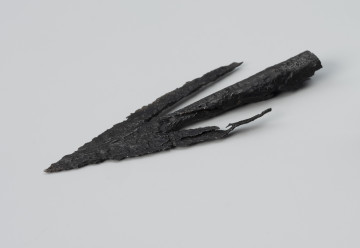
Clay rattle
980 — 1100
National Museum in Szczecin
Part of the collection: Middle Ages
The amulet found in the Cedynia burial ground was made from the tooth of a small carnivore, probably a fox, by drilling a hole in the top to hang it from a thong. The strength and cleverness of the wild animal were supposed to protect the wearer from all external evil, as well as from disease, and to fill them with strength and hope. Early medieval pendants associated with various beliefs are known in Western Pomerania. The oldest were linked to Slavic and Scandinavian pagan mythology. In addition to amulets made of animal bones, teeth, and fish vertebrae, the Slavs also wore lunulas and kaptorgas. Lunulas are crescent-shaped pendants, found most commonly among women. Kaptorgas, on the other hand, were originally small containers for small items of special significance, in which crosses also came to be stored over time. In the archaeological material, on the other hand, signs of the presence of Scandinavians or their influence in Pomerania are metal or amber hammers of Thor, as well as other objects decorated with runes or ornaments characteristic of this people. With the advent of Christianity, crosses made from a variety of raw materials began to appear and become more popular over time. However, old beliefs and traditions, associated with the magical and animistic thinking of pagan religions, persisted for a long time in the societies of Western Pomerania. Ewa Górkiewicz-Bucka
Author / creator
Object type
amulet, animal bone, pendicle
Technique
drilling
Material
animal tooth
Origin / acquisition method
field research
Creation time / dating
Creation / finding place
Owner
Muzeum Narodowe w Szczecinie
Identification number
Location / status

980 — 1100
National Museum in Szczecin

150 — 200
National Museum in Szczecin

951 — 1050
National Museum in Szczecin
DISCOVER this TOPIC
Museum of King Jan III's Palace at Wilanów
DISCOVER this PATH
Educational path